Midterm Today:
- Use quiet voices -- other classes are beginning their tests
- Turn-in report, slideshow, or movie.
- Briefly share materials and methods
- Make fire
Homework:
- Car must be working by next class (Tuesday, 1/24)
Warm-Up: Suppose you want to break a small log into two pieces by whacking it against a rock. If you swing the log as shown below, at what point along the length of the log should it contact the rock? Why?

- Things to remember about the midterm project: becoming proficient at making fire will take a lot of work; follow the rubric; you are allowed to use your own mechanical inventions (pulleys, gears, levers...)
- Pass out white pine
- Work time.
Homework:
- Complete midterm project. Do not expect work time on the day of the midterm [Blue 1: Tuesday, 9-11; Blue2: Wednesday, 11:45-1:45]
- Cars must be working by the beginning of class on Tuesday after midterms (1/24). "Working" means that the car should travel several meters powered by its mechanical stored energy source. If you want to come in and work during exam week, feel free to come in between 8 and 9 or between 1:45 and 3. If you're coming in between 1:45 and 3, let Mr. Stapleton know in advance.
 Warm-Up:
Warm-Up:
The hourglass on the right will remain (for a while) at the bottom of the glass of water. At what point will the hourglass float to the surface? Why?
Today: hot glue rationing- Check homework. How did it go? Questions?
- Questions regarding fire project?
- Work time -- hopefully, begin car activities. #3-#18 are due on 1/26. Enter your group's data into this spreadsheet -- Car Activities Answers Spreadsheet
Homework:
Work on midterm project and/or cars
Warm-Up:
What steps are involved in building a fire with friction?
Today:- Quick check on spreadsheet fiddling
- Pointers on the homework
- Some fire-making tools
- Block 2 -- hand out car activities
- Car work time
Homework:
2009 rotational motion test #14-22. Use interactive version to check your answers. Video help: 4-16,17, 18, 19, 20, 21, 22 Click here for the test shown in the videos.
Warm-Up:
A spring is stretched 0.3m beyond its resting length. The force required to hold the spring at this stretch distance is 100N. Approximately how much energy is required to stretch the spring to this distance?If the spring is used to power a car, what is the car's theoretical maximum KE?
Today:
- Discuss upcoming events/calendar. Fire-making midterm or conventional test? Fire-making ideas
- How to complete the homework.
- Car work time. At this point, think of your car as a
prototype.
Wednesday, 1/4 Friday, 1/6 Tuesday, 1/10 Thursday, 1/12 - Prototype Car Work time: 45 minutes
- Homework: car activity #1.
- Fire-making demo
- Discuss spreadsheet homework
- Prototype Car Work time -- approx. 1 hour
- Tonight's Homework: 2009 test #14-22
- Discuss Homework.
- Work on Car Activities #3-18
- Work Time: cars and/or midterm project. No more car deadlines until after midterms.
Tuesday, 1/24 Thursday, 1/26 Monday, 1/30 Wednesday, 2/1 - First "road test"
- Get high speed video footage
- Modify cars
- Car Activities #3-18 are due next class.
- Quiz over some questions from the 2009 test.
- Car actitivities #3-18 are due today
- Video analysis
- Complete Car Activities 19-22 -- due next class
- Final in-class car work time
- Test preparation?
- Test -- like the 2009 interactive test
Friday, 2/3 Final Car Competition
Homework: Complete Car Activity #1 (activities handout). Use this spreadsheet.
Problem of the Week (1% extra credit):
Create an excel spreadsheet that will determine the period of a pendulum "bob" for any initial displacement -- and any values of the other yellow inputs, below. Most textbooks provide a formula that is an approximation that only works at small angles of displacement. It is not necessary to include the effects of friction. For the conditions below, the period (swing over and back) is about 6.5s. As used below, "displacement" is the angle between the pendulum string and its position if it were not swinging.
| For a spherical bob on a string of negligable mass, friction, and surface area… | |
| string length (m) | 10 |
|
Initial String Displacement (degrees) |
40 |
| Bob Density (g/cm^3) | 0.019099 |
| Bob Mass (kg) | 9.999998 |
| Bob Volume (cm^3) | 523598.8 |
| Bob Radius (cm) | 50 |
|
Bob Cross-Sectional Area (m^2) |
0.785398 |
| Bob Cd | 0.5 |
| Air Density (kg/m^3) | 0 |
| Time Increments (s) | 0.001 |
Warm-Up:
What does a differential do in a car? How does it work? Video "tutorial."
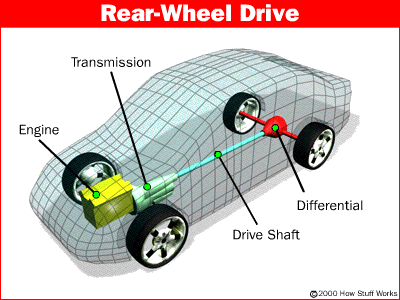
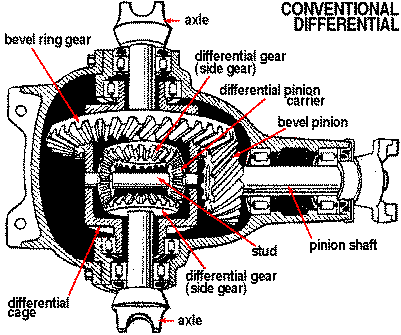
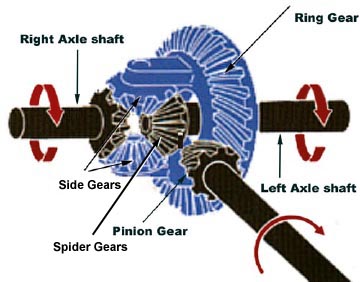
Today:
- Quick check for homework completion.
- Pop a bottle.
- Measure coefficient of friction of rubber bands on tile.
- Each group must turn in an informal table of features that will make your car fast -- and why. Keep each row brief.
| Features that will make our car fast | Why this feature makes the car fast |
Next Class: Quickly check the homework. Then work on cars.
Homework: None. Work on cars if you want to.

Warm-Up: Get one of the fancy yoyos with a "patented clutch," and try it.

- Try to figure out what the clutch is supposed to do -- and how it works.
- Can you make the yoyo "stall" at the end of the string? What sort of energy does it have when it has stalled? PE, KE, or neither?
- Forget about rotational KE for the moment. The yoyo travels downward; then it reverses its direction and travels upward. How fast is it moving at the bottom? What happens to its translational KE at the bottom?
Today:
- Check for brainstormed car ideas.
- See new rule, highlighted in yellow below (last class)
- Do some practice problems.
- Form groups and begin designing cars. Make a plan and a materials list. The plan should include a drawing and an explanation of why your car will be fast. **For cars employing extreme force, your plan must include safety protocols** [500N is approximately 112pounds. That's enough to cause injury in certain circumstances.]
- Find the coefficient of static friction of rubber bands on school floor tiles. See if/how it varies with different contact areas.
Next Class: Quickly check the homework. Then work on cars.
Homework:
- By the end of next class, turn in one plan and one materials list for your group (one per group). This should include some explanation of what features will make your car fast. Think of this as a hypothesis; you don't have to be right.
- Complete #6-7 and 11-13 on 2009 rotational motion test. **For #6 and 7, the disc's mass is 2kg. Check your answers with the spreadsheet. Watch these videos if you need help 6-7, 11-13
Warm-Up: When the green string is wound around the axle, the car on the right will move. Will the force applied by the wheels (to the road) be a strong one or a weak one? Why?
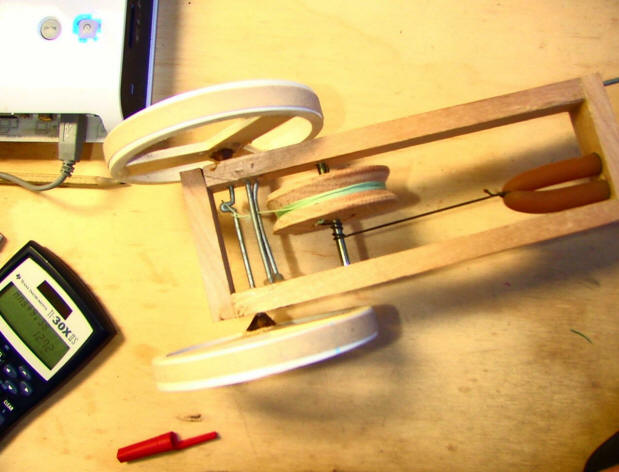
Today:
- Return homework. Check recent homework.
- Experiment with different combinations of wheels, axles, and frames.
- Begin designing cars
Homework: Brainstorm car design ideas. On a sheet of paper, write down ideas relating to the car design problem below. Come up with as many ideas as possible. At this point, do not worry about coming up with good ideas.
- Goal: highest top speed in a straight line. Top speed will be measured as the highest velocity vector perpendicular to a floor tile in the hallway outside the gym.Maximum total force exerted by energy source(s) = 500N
- Rotating parts must be removable (so that we can measure their moments of inertia and the normal forces of the frame against the axles).
- Car must fit inside a 50cm cube
- Energy must come from mechanical PE
- Car must be powered by a drive axle causing the wheels to push against the road.
- No portion of the car may fall off (though parts may drag).
- No pre-made parts are allowed; basic raw materials and creatively reused parts are okay.
- The following materials will be provided: hot glue, nails and wire (for axles), various tools, rubber bands, cardboard, wood (pine strips, approximately 40cm x 1cm x 2cm)
- Circle cutter or makeshift "lathe"
- The "car" must roll on wheels.
- If you have any other questionable ideas, ask Mr. S.
Warm-Up:

Your car has too much torque. Its wheels are spinning, and it is therefore losing energy. How can you keep the same torque without losing energy?
Today:
- Turn-in homework.
- Collect Moment of Inertia Data.
- Predict race winners
- Ramp race.
Homework:
- Rotational Motion handout p 15 # 8-10. Use interactive version to check your answers. Watch these videos if you have trouble 8 9 10
Warm-Up:
The wheels rotate 14 times while the mass drops 40cm. What is the axle's radius?

Today:
- Return part III of test
- Check/discuss homework
- Measure axles' moments of inertia
- Predict axle race winners; run race. Make simple cars with two axles and repeat.
Homework:
- Rotational Motion handout p.15 #1-5. Links to video help #1-2, 3-4. I'm not sure what happened to #5. You'll just need to use T=I*alpha and solve for I. T and alpha come from prior problems. The interactive version of the 2009 test may be helpful. You can change the givens and it will calculate new answers.
Warm-Up:
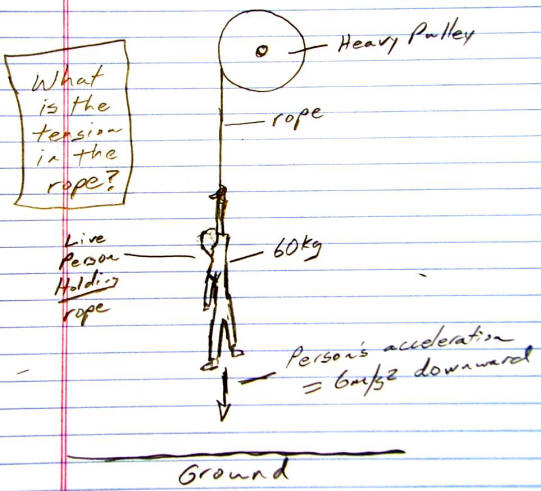
Today:
- Turn in Dart Design "Report" (part III of unit test)
- Discuss test. Return library portion of test
- Introduction to rotational motion problems: torque practice problems; then attempt to make a fast-rolling wheel/axle and measure its moment of inertia.
Homework:
- Rotational Motion handout (p. 13,14): Complete #1e through #2d.
- Review Chapter 8 in textbook (all except last section, 8-8)
Extra Stuff: Video solutions to Test [please excuse the hands]: #1-2, 3-4,6-7,8, 9, 10, 11-13, 14-16,17, 18, 19, 20, 21, 22 Click here for the test shown in the videos.
Test in Library
Warm-Up:
Why do partially used toilet paper rolls wind up on the table in the math/science office?

Dart Results -- the class averages are now correct; sorting them along with the individual scores caused problems...
| Rank | Name | Vo (m/s) | Vo (mph) | CdA | Block |
| 1 | Natalie :-) | 38.6 | 86.464 | 3.70E-05 | 2 |
| 2 | Stapleton | 49 | 109.76 | 5.10E-05 | |
| 3 | Elena* | 88 | 197.12 | 9.40E-05 | 1 |
| 4 | Erin | 68 | 152.32 | 9.60E-05 | 2 |
| 5 | Steven | 90 | 201.6 | 1.09E-04 | 2 |
| 6 | Nancy | 100 | 224 | 1.20E-04 | 2 |
| 7 | Sage | 35.3 | 79.072 | 1.30E-04 | 1 |
| 8 | Seth | 88.4 | 198.016 | 1.32E-04 | 1 |
| 9 | Esmir | 96 | 215.04 | 1.33E-04 | 2 |
| 10 | Anna | 60 | 134.4 | 1.35E-04 | 2 |
| 11 | Julianna | 55.5 | 124.32 | 1.47E-04 | 1 |
| 12 | Frank* | 37.5 | 84 | 1.57E-04 | 1 |
| 13 | Geoff | 44 | 98.56 | 1.70E-04 | 1 |
| 14 | Aaron S. | 48 | 107.52 | 1.80E-04 | 1 |
| 15 | Tom | 92 | 206.08 | 1.80E-04 | 2 |
| 16 | Matt | 87 | 194.88 | 1.92E-04 | 2 |
| 17 | Michaela | 57 | 127.68 | 2.00E-04 | 1 |
| 18 | Cody | 90 | 201.6 | 2.00E-04 | 2 |
| 19 | Louis | 73.3 | 164.192 | 2.10E-04 | 1 |
| 20 | Hai | 39 | 87.36 | 2.43E-04 | 1 |
| 21 | Lauren | 73.5 | 164.64 | 3.45E-04 | 1 |
| 22 | Kevin | 51 | 114.24 | 3.86E-04 | 1 |
| 23 | Rachel | 92 | 206.08 | 3.96E-04 | 2 |
| 24 | Aaron H* | 60 | 134.4 | 5.60E-04 | 2 |
| 25 | James | 90 | 201.6 | 6.85E-04 | 2 |
| 26 | Nell | 90 | 201.6 | 7.19E-04 | 2 |
| 27 | Jonas | 96 | 215.04 | 7.56E-04 | 2 |
| 28 | Emma | 26.25 | 58.8 | 7.60E-04 | 2 |
| 29 | Alex | 87 | 194.88 | 1.70E-03 | 2 |
| 30 | Facey | 46.7 | 104.608 | 1.90E-03 | 1 |
| 31 | Phi | ? | #VALUE! | ? | 2 |
| 32 | Block 2 Average | 4.24E-04 | |||
| 33 | Block 1 Average | 3.30E-04 |
Today:
- Questions about Tuesday's Spreadsheet Test? First, create a working spreadsheet. Second, use your spreadsheet to find the drag coefficient of a paper dart. You will be given the dart's release height, release angle, mass, cross-sectional area, initial speed, and horizontal distance traveled. Save your spreadsheet with the correct Cd in place, and deposit it in Mr. Stapleton's drop folder. Third, you must watch a 600fps video of a dart passing a meter stick. From the video, you must determine the dart's speed.
- Details relating to the "report" that is due next thursday
- Find the value of your CdA?
- Work on Torque Problem
Homework: Be ready to create a spreadsheet from scratch.
Warm-Up:
When you are throwing a Frisbee™, it is sometimes suggested that you "keep the fast side down." What does that mean? Why would one want to do such a thing?
Today:
- Make darts (20 minutes, 1 sheet of paper, 20cm scotch tape, 4.2g-4.8g total mass)
- Launch darts???
- Introduction to Rotational Motion (car) concepts.
Unit Test (3 parts):
- 1/3 = Wednesday. In 20 minutes or less, create a stabile paper dart. We will launch the dart and collect video and photo data.
- 1/3 = Next Tuesday (12/6). In the library, use Open Office to create a spreadsheet (from scratch) to determine dart's Cd. Determine the Cd of your dart and of Mr. Stapleton's dart.
- 1/3 = Due next Thursday(12/8). "Report" demonstrating your knowledge of stability, CM, CP, drag equation, etc. Details will be provided next class (Thursday, 12/1)
Homework: Prepare for unit test.
- Practice making a dart for next class
- Practice creating spreadsheets (for Tuesday). Learn to deal with Open Office.
Warm-Up:
1. A 0.2kg meter stick and a 1kg rock are dropped from a tall building in a vacuum on the Earth. How do their fall times compare? Why?
2. How do their fall times compare on the Earth? Why?
3. What will happen if the rock is taped to one end of the meter stick?
Today:
- JupiterGrades is updated
- Return and discuss homework
- Don't forget to turn in your Cd determinations.
- Prepare for unit test. Options: begin work on your dart design; practice spreadsheet preparation;
- Next Unit: Cars powered by mechanical PE
Unit Test (3 parts):
- 1/3 = Wednesday. In 20 minutes or less, create a stabile paper dart. We will launch the dart and collect video and photo data.
- 1/3 = Next Tuesday. Create a spreadsheet (from scratch) to determine dart's Cd. Determine the Cd of your dart and of Mr. Stapleton's dart.
- 1/3 = Due next Thursday(12/8). "Report" demonstrating your knowledge of stability, CM, CP, drag equation, etc. Details will be provided next class (Thursday, 12/1)
Homework: Prepare for unit test.
- Practice making a dart for next class
- Practice creating spreadsheets (for Tuesday)
Warm-Up: Wood does not float in the air. Why does fine sawdust float in the air? Why do clouds float? Why do any solids or liquids float in air?
Today:
- Turn-in homework
- Quiz
- Calculate your rocket's Vo, Time in free flight, and Cd from the pressurized air video. Do this in one of two ways: 1) using elapsed time [after 4.5m elevation] and Vo at the point of max speed 2) using Vo at the point of max speed, and final velocity
Homework: None.
Warm-Up: Why are rockets generally more stable when launched with pressurized air and water (versus the slingshot)?

- Determine Cd winners. Award donuts.
- Prepare for launch -- 500ml water. Measure new mass if mass has changed.
- Clarify homework and Monday's quiz
Here are some launch videos: pressurized water launch; slingshot launch -- full flight; slingshot -- wobbly rocket; winning rocket (I think) slingshot take-off
Homework:
- Prepare for a quiz on Monday, 11/21. The quiz will be over problems like #1-11 on the "Test Review Problems" sheet. You will have a chance to ask questions about these problems on Thursday.
- Complete #12-14 on the "Test Review Problems" sheet. These are due on Monday, 11/21.
Warm-Up: What is the product of (x-a)(x-b)(x-c)...(x-z) ?
Today:
1. Prepare for launches. Obtain 500ml of water and take it with you to the field.
2. Launch rockets two ways (slingshot and 500ml water plus 90psi air) and record observations/data.
- Record: launch angle, launch height, horizontal flight distance, and air density. This will be added to a class data table.
- Make visual observations regarding rocket flights.
- Video rocket flights.
2. Design and implement a parachute deployment system for your rocket.
Homework:
- Prepare for a quiz on Monday, 11/21. The quiz will be over problems like #1-11 on the "Test Review Problems" sheet. You will have a chance to ask questions about these problems on Thursday.
- Complete #12-14 on the "Test Review Problems" sheet. These are due on Monday, 11/21.
Warm-Up:
What is the product of (x-a)(x-b)(x-c)...(x-z) ?
Hopefully, you won't have to wait until Tuesday for an answer.
Today:
- Finish your rocket. If possible, try to construct your rocket from water-resistant materials. It may be wet when we launch your rocket, and at some point you will be launching your rocket with water.
- Find, record, and save your finished rocket's mass.
- Measure your bottle's cross-sectional area. I am hereby restating your goal to be minimizing the force of drag acting on your rocket. This is not exactly the same as minimizing your Cd. It includes minimizing both Cd and Area. Therefore, for purposes of comparison, we will assume your rocket's cross-sectional area to be that of a standard 2-liter bottle. If you do significantly increase your rocket's cross-sectional area, that will be reflected in a higher calculated Cd (a worse Cd).
- Compare your measured cross-sectional area with other groups, and arrive at an agreed-upon number that will be used by the entire class.
- ***If you have time, make a paper "bullet" to be launched from a potato gun. Your bullet can consist of no more than one sheet of copy paper and 30cm of scotch tape. It will be fired by cramming the bullet into a potato gun barrel and then by stuffing a "wadding" of cotton or tissue behind the projectile. Your goal should be to produce a bullet that will travel as far as possible when launched at a 45degree angle. I just tested the process in the hallway, and it worked really, really well. I used my "dart," but I snipped the tip.
Homework:
- Dress for a trip outside (on the mucky baseball field) on Tuesday.
- Prepare for a quiz on Monday, 11/21. The quiz will be over problems like #1-11 on the "Test Review Problems" sheet. You will have a chance to ask questions about these problems next Thursday.
- Complete #12-18 on the "Test Review Problems" sheet. These are due on Monday, 11/21.
Warm-Up:
What are the fastest animals of the land, sea, and air? How do they accomplish such feats of speed?
links: animals fish speed video fastest creature video measuring cheetah speed top 10 fastest fish
Today:
- Check and go over homework.
- Return paper rocket questions.
- Build bottle rockets.
Next Classes: Mr. Stapleton will not be here on Friday. Finish your rockets and make bullets. Hopefully, we will launch stuff on Tuesday. Dress accordingly.
Warm-Up:
You are given a book stacking challenge. Your challenge is to stack four books so that the top book sticks out as far as possible beyond the edge of the bottom book. If the "books" are boxes of uniform density, how many booklengths can then top book protrude?
Today:
- Check and go over homework.
- Paper rocket questions haven't been graded.
- How to set up a trajectory spreadsheet including drag -- if, then statements. See correct outputs, below.
- Create a drag trajectory spreadsheet by filling in this template with the appropriate formulas. They should look like the one below, and they should include trajectory graphs of "Y Position vs. X Position." Turn in your finished spreadsheet via email.
Homework: Questions to answer using your spreadsheet.
- If you throw a baseball straight upward with a velocity of 20m/s, will it take longer to return to the ground in a vacuum or in real air? Assume Cd =0.3; A= 0.0043m2; air density = 1.22kg/m3; and mass = 0.125kg. How long will it stay aloft in air? How about a vacuum?
- Three identical baseballs off of a cliff with spees of 25m/s. Ball A is thrown upward at an angle of 45 degrees. Ball B is thrown horizontally. Ball C is thrown downward at an angle of 45 degrees. If the cliff height is 100m, what are the speeds of the balls when they hit the ground?
- Suppose you are throwing a ball off of a cliff of infinite height (but assume that gravity does not vary). You are throwing a baseball with the measurements above and an initial speed of 25m/s. At what approximate angle should you throw the ball in order for the ball to attain the highest maximum speed on its downward flight?
Be ready to begin work on aerodynamic rockets.
| Drag Coefficient (Cd) | 0.4 | ||||||||||
| Cross-Sectional Area (m^2) | 0.007853982 | ||||||||||
| Density of Air (kg/m^3) | 1.19 | ||||||||||
| Projectile Mass (kg) | 0.2 | ||||||||||
| Initial Velocity (m/s) | 30 |
Terminal Velocity (m/s) |
32.38132507 | ||||||||
|
Launch Angle (degrees) |
50 | Maximum Speed (m/s) | 30 | ||||||||
| Time increments (s) | 0.2 | ||||||||||
| time (s) |
Current X velocity (m/s) |
Current Y velocity (m/s) |
Speed (m/s) | X Drag (N) | Y drag (N) | X Net Force (N) | Y Net Force (N) | X acceleration (m/s^2) | Y Acceleration (m/s^2) |
X positon (m) |
Y positon (m) |
| 0 | 19.28362829 | 22.98133329 | 30 | -0.69509528 | -0.98722758 | -0.69509528 | -2.9472276 | -3.475476415 | -14.7361379 | 0 | 0 |
| 0.2 | 18.58853301 | 20.03410571 | 27.32945208 | -0.64588779 | -0.75025131 | -0.64588779 | -2.7102513 | -3.229438933 | -13.5512565 | 3.787216 | 4.301544 |
| 0.4 | 17.94264522 | 17.3238544 | 24.9410194 | -0.60178281 | -0.56099099 | -0.60178281 | -2.520991 | -3.008914053 | -12.604955 | 7.440334 | 8.03734 |
| 0.6 | 17.34086241 | 14.80286341 | 22.79978672 | -0.56209306 | -0.40959845 | -0.56209306 | -2.3695984 | -2.8104653 | -11.8479922 | 10.96868 | 11.25001 |
| 0.8 | 16.77876935 | 12.43326496 | 20.88332298 | -0.52624387 | -0.28895966 | -0.52624387 | -2.2489597 | -2.631219329 | -11.2447983 | 14.38065 | 13.97362 |
| 1 | 16.25252548 | 10.1843053 | 19.1797982 | -0.49375164 | -0.1938785 | -0.49375164 | -2.1538785 | -2.468758193 | -10.7693925 | 17.68378 | 16.23538 |
| 1.2 | 15.75877385 | 8.030426801 | 17.68690781 | -0.464207 | -0.12054358 | -0.464207 | -2.0805436 | -2.321034997 | -10.4027179 | 20.88491 | 18.05685 |
| 1.4 | 15.29456685 | 5.949883218 | 16.41112078 | -0.43726146 | -0.06617344 | -0.43726146 | -2.0261734 | -2.186307309 | -10.1308672 | 23.99024 | 19.45489 |
| 1.6 | 14.85730539 | 3.923709777 | 15.36668545 | -0.41261683 | -0.028778 | -0.41261683 | -1.988778 | -2.063084153 | -9.94388999 | 27.00543 | 20.44225 |
| 1.8 | 14.44468855 | 1.934931778 | 14.57370881 | -0.3900167 | -0.00699839 | -0.3900167 | -1.9669984 | -1.950083499 | -9.83499195 | 29.93563 | 21.02811 |
| 2 | 14.05467185 | -0.03206661 | 14.05470844 | -0.36923959 | 1.92209E-06 | -0.36923959 | -1.9599981 | -1.846197945 | -9.79999039 | 32.78556 | 21.2184 |
| 2.2 | 13.68543227 | -1.99206469 | 13.82965575 | -0.35009336 | 0.007417776 | -0.35009336 | -1.9525822 | -1.750466814 | -9.76291112 | 35.55957 | 21.01598 |
| 2.4 | 13.3353389 | -3.94464691 | 13.90652735 | -0.33241067 | 0.02908594 | -0.33241067 | -1.9309141 | -1.66205334 | -9.6545703 | 38.26165 | 20.42231 |
| 2.6 | 13.00292823 | -5.87556097 | 14.2687897 | -0.31604518 | 0.064530572 | -0.31604518 | -1.8954694 | -1.580225894 | -9.47734714 | 40.89548 | 19.44029 |
| 2.8 | 12.68688306 | -7.7710304 | 14.87769859 | -0.30086849 | 0.112881833 | -0.30086849 | -1.8471182 | -1.504342469 | -9.23559083 | 43.46446 | 18.07563 |
| 3 | 12.38601456 | -9.61814857 | 15.68190481 | -0.28676755 | 0.172921821 | -0.28676755 | -1.7870782 | -1.433837767 | -8.93539089 | 45.97175 | 16.33671 |